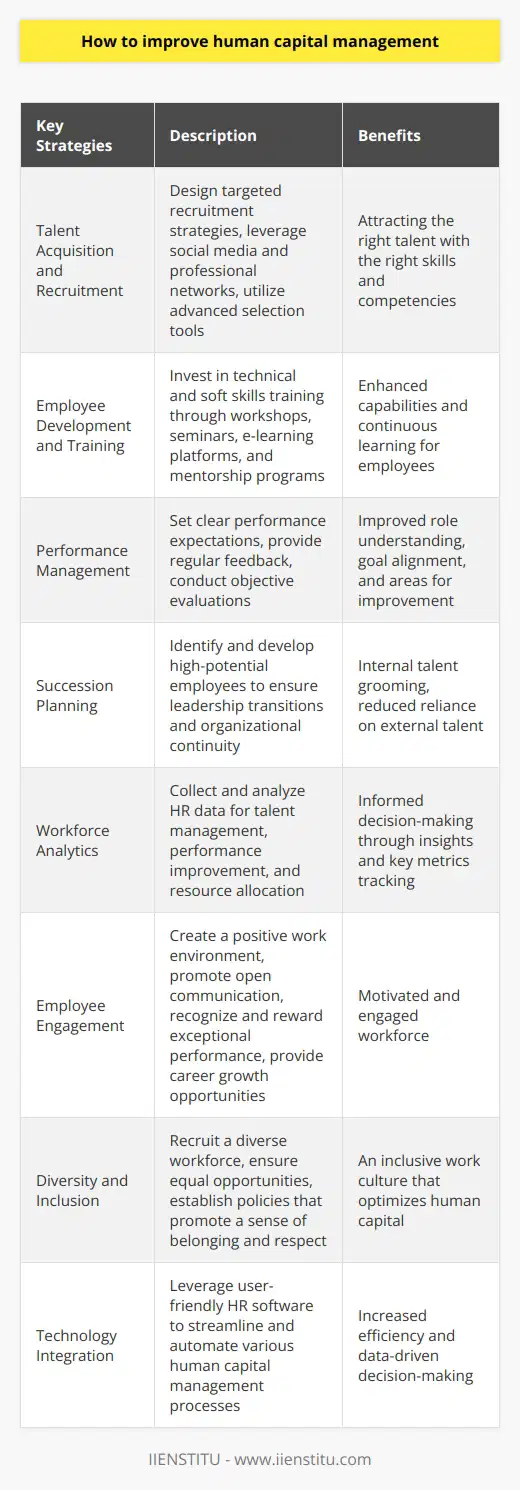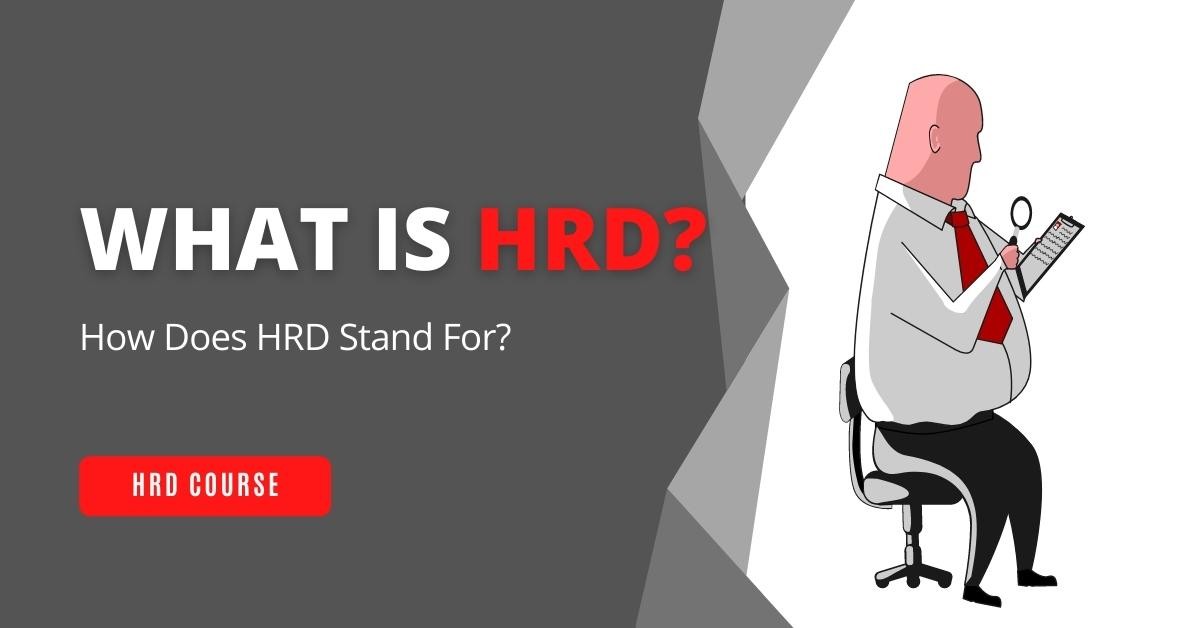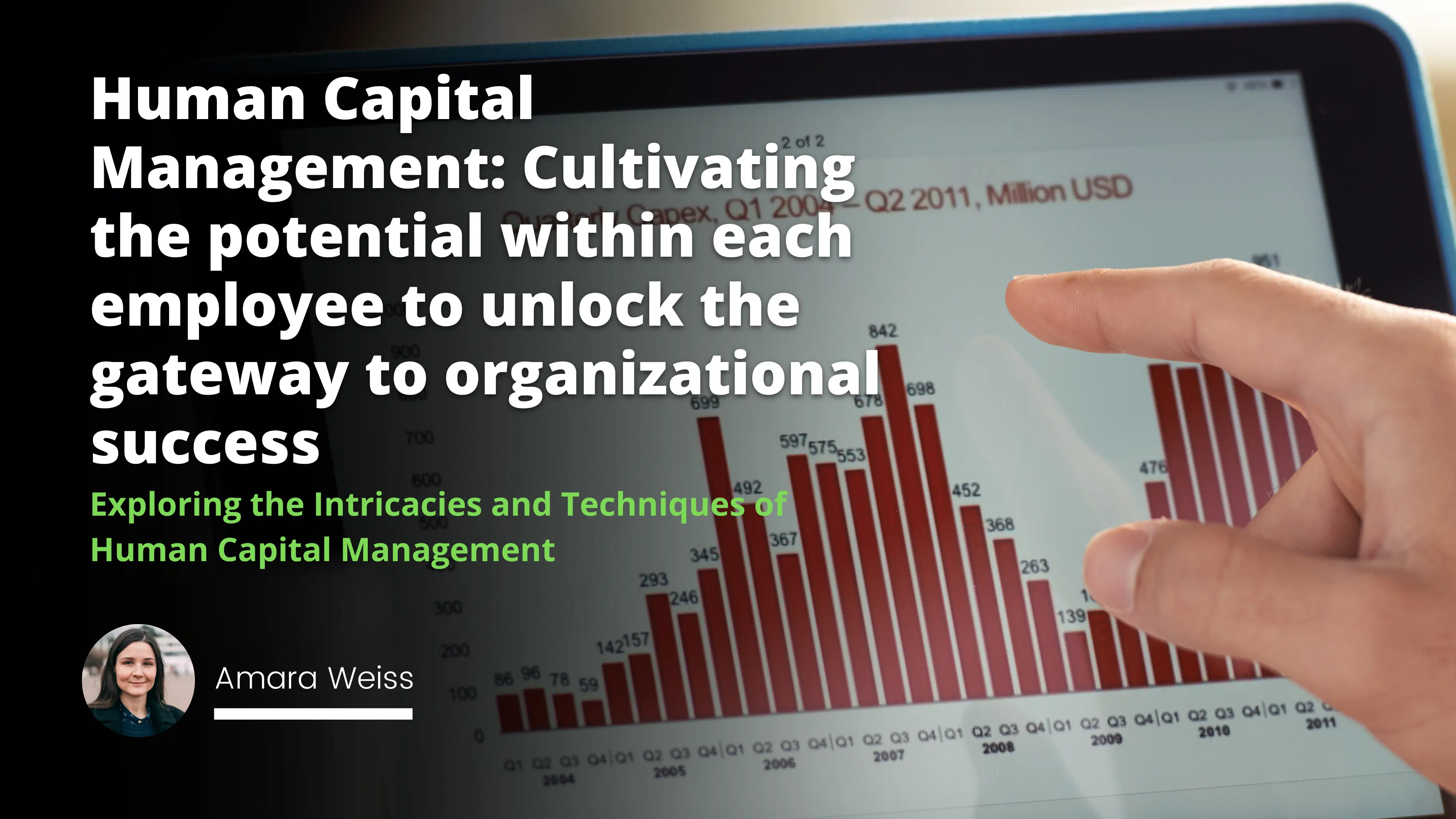
Welcome to the ever-evolving world of work, where the driving force behind every organization's success lies in its people's talents, skills, and expertise. Enter the fascinating realm of Human Capital Management (HCM) - an essential discipline beyond conventional HR practices, strategically transforming how businesses grow and thrive. In this insightful blog post, we will delve into the art and science of HCM, uncovering its fundamental principles, practices, and impact on organizations across the globe. Join us on this illuminating journey as we explore how HCM is reshaping the workplace and empowering companies to harness the full potential of their most valuable asset: their people.
The Definition of Human Capital Management:
Human Capital Management (HCM) is a comprehensive approach to managing an organization's workforce, encompassing recruitment, employee engagement, talent development, and retention strategies. It aims to optimize the value and potential of employees by treating them as vital assets, ensuring their professional growth aligns with the organization's goals.
In addition, HCM extends beyond traditional HR practices by focusing on strategic planning, performance analysis, and the utilization of technology to enhance workforce management.
HRMS (Human Resource Management System)
Related Course: Hr Training
An HRMS software solution streamlines and automates various HR processes, such as payroll, benefits administration, and employee records management. It simplifies tasks, reduces errors, and improves efficiency in managing employee data. HRMS solutions are often integrated with HCM systems to enhance the organization's ability to manage its workforce effectively.
HCM (Human Capital Management):
HCM is a holistic approach that combines the best practices of human resources management and talent management. It focuses on the entire employee lifecycle, from hiring and onboarding to performance management and succession planning. By integrating these processes, HCM empowers organizations to make informed decisions about workforce planning, talent acquisition, and employee development.
Key Benefits of an HCM Solution:
Implementing an HCM solution offers numerous advantages, some of which include the following:
Attract and Retain Talent: HCM solutions help organizations develop a strong employer brand, attract top talent, and create a positive work environment that encourages employee retention. By streamlining recruitment processes and providing opportunities for professional development, HCM solutions can reduce employee turnover.
Respond with Agility to Change: An HCM solution allows organizations to monitor workforce trends, anticipate changes, and adapt quickly to evolving market conditions. With real-time data analysis and decision-making tools, HCM enables businesses to respond proactively to shifts in their industry.
Optimize Workforce Management and Spending: Using an HCM solution, companies can optimize workforce planning, scheduling, and budgeting. This ensures that resources are allocated efficiently, reducing unnecessary costs and improving overall productivity.
Streamline HR Operations: HCM solutions automate and simplify many routine HR tasks, such as payroll processing, benefits administration, and performance management. This leads to increased efficiency, reduced errors, and more time for HR professionals to focus on strategic initiatives that drive organizational growth.
Enhance Employee Engagement and Satisfaction: HCM solutions can play a crucial role in boosting employee engagement and satisfaction levels by providing tools for transparent communication, continuous feedback, and recognition of achievements. By fostering an open dialogue and appreciation culture, organizations can improve employee morale and motivation, leading to higher productivity and reduced turnover.
Facilitate Talent Development and Succession Planning: A comprehensive HCM system supports talent development by identifying skill gaps, offering targeted training programs, and tracking employee progress. This enables organizations to nurture and grow their in-house talent pool, ensuring a steady pipeline of future leaders. HCM solutions also facilitate succession planning by identifying potential successors for critical positions and preparing them for leadership roles.
Promote Data-Driven Decision Making: By centralizing and organizing workforce data, HCM solutions enable organizations to make informed, data-driven decisions about various aspects of human capital management. Advanced analytics and reporting tools provide insights into workforce trends, helping organizations identify improvement areas and implement strategic initiatives to address them.
Enhance Compliance and Risk Management: HCM solutions assist organizations in maintaining compliance with local, national, and international labor laws and regulations. By automating record-keeping and reporting processes, HCM systems help businesses minimize the risk of non-compliance and potential legal penalties. Additionally, HCM solutions offer tools for tracking employee performance and identifying potential risks, such as high turnover or low engagement, allowing organizations to address these issues proactively.
Foster a Collaborative and Inclusive Work Environment: An effective HCM solution encourages collaboration and inclusivity within the workplace by offering tools for communication, knowledge sharing, and teamwork. By breaking down silos and promoting a sense of belonging, HCM systems create a diverse and inclusive work environment where all employees can thrive.
Related Course: Leadership Training Course
In conclusion, Human Capital Management (HCM) is an integral approach for organizations looking to maximize the potential of their workforce and achieve sustained success. By implementing an HCM solution, businesses can attract and retain top talent, optimize workforce management, streamline HR operations, and foster a collaborative and inclusive work environment. This ultimately leads to improved employee engagement, higher productivity, and better organizational performance.
HRIS (Human Resource Information System)
An HRIS is a specialized software platform that stores and manages employee data, such as personal information, job descriptions, and employment history. It allows organizations to easily access, analyze, and report on workforce data, helping them make data-driven decisions. HRIS solutions may be integrated with HRMS and HCM systems to provide a comprehensive view of the organization's workforce.
Elevating Employee Experience: The Synergy Between Human Capital Management and Employee Experience
Human Capital Management (HCM) and Employee Experience (EX) are intrinsically linked, which is crucial in fostering a thriving and productive work environment. HCM focuses on optimizing the value of an organization's workforce through strategic planning, talent acquisition, development, and retention. On the other hand, Employee Experience encompasses the entire journey an employee goes through within the organization, including their perception of the work environment, culture, and growth opportunities.
A successful HCM strategy prioritizes enhancing the employee experience by creating a supportive, engaging, and inclusive workplace that empowers employees to reach their full potential. This, in turn, leads to increased job satisfaction, higher retention rates, and improved overall performance. By recognizing and nurturing the synergy between HCM and Employee Experience, organizations can unlock the key to a thriving workforce and sustainable success.
Decoding Workforce Management: Distinguishing Human Capital Management from Human Resource Management
Human Capital Management (HCM) and Human Resource Management (HRM) are often used interchangeably; however, they have distinct focuses and scopes. While both HCM and HRM are concerned with managing an organization's workforce, the key differences lie in their approach, strategic objectives, and the extent of their impact on organizational success.
Approach:
Human Capital Management (HCM) considers employees valuable assets whose potential can be developed, nurtured, and strategically utilized for organizational success. HCM takes a holistic approach to manage the workforce, emphasizing the importance of aligning employee goals with the organization's broader objectives. It focuses on the entire employee lifecycle, from recruitment to talent development and retention.
Human Resource Management (HRM) primarily deals with the administrative and operational aspects of managing an organization's workforce. HRM encompasses hiring, payroll processing, benefits administration, and employee relations. While HRM recognizes employees' importance, its approach is more transactional and less strategic than HCM.
Strategic Objectives:
HCM aims to optimize the value of employees by strategically managing their skills, talents, and potential. It emphasizes talent acquisition, employee engagement, professional development, and retention as critical drivers of organizational success. HCM focuses on creating a supportive work environment that fosters growth and maximizes employees' contributions to the organization.
HRM's primary objective is to ensure the organization's smooth functioning of HR-related processes. Its focus is on managing the day-to-day aspects of the workforce, such as recruitment, onboarding, employee records management, and legal compliance. While HRM contributes to organizational success, its strategic impact is typically less pronounced than HCM.
Impact on Organizational Success:
HCM has a more direct and profound impact on an organization's success due to its strategic focus on developing and retaining top talent, fostering employee engagement, and aligning workforce goals with its objectives. By leveraging human capital effectively, HCM can drive innovation, productivity, and competitive advantage.
HRM contributes to organizational success by ensuring the efficient management of HR processes and the overall well-being of the workforce. While its impact may be less transformative than HCM, HRM plays a critical role in maintaining the stability and integrity of the organization's workforce.
In summary, the main difference between Human Capital Management and Human Resource Management lies in their approach, strategic objectives, and the extent of their impact on organizational success. HCM adopts a more strategic and holistic perspective, focusing on maximizing employees' potential as valuable assets, while HRM concentrates on the administrative and operational aspects of managing the workforce.
Unleashing the Power of Human Capital Management: Streamlining Administrative Functions and Empowering Your Workforce
In today's rapidly evolving business landscape, organizations must adapt and innovate to stay ahead of the competition. One essential component in driving growth and success is practical Human Capital Management (HCM). In addition, HCM plays a crucial role in optimizing the value of an organization's workforce through strategic planning, talent acquisition, development, and retention. In this blog post, we will explore the connections between HCM, administrative functions, service delivery, and employee management, along with the role of software applications in streamlining core HR functions.
The Synergy Between HCM and Administrative Functions:
HCM and administrative functions are intrinsically linked and vital in efficient employee management and service delivery. HCM strategies focus on nurturing and developing employees as valuable assets, while administrative functions ensure the organization's smooth functioning of HR-related processes. By integrating HCM and administrative functions, organizations can create a more cohesive and streamlined approach to managing their workforce, resulting in improved productivity and overall performance.
The Role of Software Applications in Streamlining Core HR Functions:
Software applications' emergence has revolutionized how organizations manage their human capital. HCM software solutions automate and simplify routine HR tasks, such as payroll processing, benefits administration, and performance management. By streamlining these core HR functions, organizations can increase efficiency, reduce errors, and free up time for HR professionals to focus on strategic initiatives that drive growth and success.
Empowering Employees Through HCM:
Effective HCM strategies empower employees by fostering a supportive work environment encourages engagement, collaboration, and professional growth. In addition, organizations can boost employee satisfaction and retention by offering tailored learning and development opportunities, promoting transparent communication, and implementing robust performance management systems. This leads to a more engaged and motivated workforce that drives innovation, productivity, and competitive advantage.
Improving Service Delivery Through HCM:
By optimizing workforce management and administrative functions, HCM plays a critical role in enhancing service delivery. Effective HCM strategies ensure that resources are allocated efficiently and that employees have the necessary skills and support to excel in their roles. This results in improved productivity, better customer service, and increased organizational success.
Reasons To Use Human Capital Management
Implementing Human Capital Management (HCM) in an organization can lead to numerous benefits that drive growth, productivity, and overall success. Here are some compelling reasons to use HCM:
Attract and Retain Top Talent: HCM focuses on creating a strong employer brand and fostering a positive work environment, which attracts top talent and encourages employee retention. By streamlining recruitment processes and providing opportunities for professional development, HCM can reduce employee turnover.
Boost Employee Engagement and Satisfaction: HCM solutions facilitate transparent communication, continuous feedback, and recognition of achievements, increasing employee engagement and satisfaction. Enhanced employee morale and motivation result in higher productivity and reduced turnover.
Optimize Workforce Management and Spending: HCM enables organizations to optimize workforce planning, scheduling, and budgeting, ensuring resources are allocated efficiently. This reduces unnecessary costs, improves productivity, and improves overall performance.
Enhance Talent Development and Succession Planning: HCM supports talent development by identifying skill gaps, offering targeted training programs, and tracking employee progress. This helps organizations nurture and grow their in-house talent pool and ensures a steady pipeline of future leaders. HCM also facilitates succession planning by identifying potential successors for critical positions and preparing them for leadership roles.
Improve Decision-Making with Data-Driven Insights: HCM centralizes and organizes workforce data, allowing organizations to make informed, data-driven decisions about various aspects of human capital management. Advanced analytics and reporting tools provide insights into workforce trends, helping organizations identify areas for improvement and implement strategic initiatives to address them.
Streamline HR Operations: HCM solutions automate and simplify many routine HR tasks, such as payroll processing, benefits administration, and performance management. This increases efficiency, reduces errors, and frees time for HR professionals to focus on strategic initiatives that drive organizational growth.
Enhance Compliance and Risk Management: HCM assists organizations in maintaining compliance with local, national, and international labor laws and regulations. HCM systems minimize the risk of non-compliance and potential legal penalties by automating record-keeping and reporting processes. Additionally, HCM solutions offer tools for tracking employee performance and identifying potential risks, allowing organizations to address these issues proactively.
Foster a Collaborative and Inclusive Work Environment: HCM encourages collaboration and inclusivity within the workplace by offering tools for communication, knowledge sharing, and teamwork. By breaking down silos and promoting a sense of belonging, HCM creates a diverse and inclusive work environment where all employees can thrive.
In conclusion, adopting Human Capital Management in an organization leads to numerous benefits, including attracting and retaining top talent, boosting employee engagement, optimizing workforce management, enhancing talent development, improving decision-making, streamlining HR operations, ensuring compliance, and fostering a collaborative work environment. These advantages ultimately contribute to improved organizational performance and sustained success.
Empowering the Workforce: Navigating Compensation, Performance, and Resource Management for Organizational Success
The success of any organization hinges on its ability to manage its most valuable asset: its people effectively. In Human Capital Management (HCM), business leaders and owners must navigate various aspects, such as compensation planning, performance reviews, and absence management, to ensure a well-coordinated workforce that aligns with their business goals. This blog post delves into the art and science of HCM, discussing how it can revolutionize workforce dynamics and drive organizational success.
Compensation Planning and Management:
A well-designed compensation strategy is critical for attracting, retaining, and motivating current employees. Business leaders must develop competitive compensation packages considering market trends, employee performance, and internal equity. Organizations can enhance employee satisfaction by effectively managing compensation and aligning financial incentives with business objectives.
Performance Reviews:
Regular performance reviews are essential for monitoring employee progress, providing feedback, and setting expectations. By implementing robust performance management systems, business owners can foster continuous improvement and ensure their employees are on track to achieve their personal and professional goals. This, in turn, contributes to improved workforce productivity and alignment with overall business goals.
Position and Absence Management:
Effective position management involves defining and structuring job roles to support organizational objectives. Business leaders must ensure that their workforce has the necessary skills and resources to excel. Additionally, efficient absence management systems are crucial for minimizing disruptions and maintaining productivity. Organizations can ensure seamless business processes and optimize workforce management by tracking and managing employee absences.
People Resource Management:
At the heart of HCM lies people resource management, which encompasses talent acquisition, development, and retention. Business owners must prioritize creating a supportive and inclusive work environment that fosters collaboration, learning, and professional growth. This approach enhances employee engagement and satisfaction and helps align individual and organizational goals, ultimately driving business success.
Aligning HCM with Business Processes and Goals:
A successful HCM strategy must be integrated with an organization's broader business processes and objectives. By aligning HCM initiatives with their business goals, leaders can ensure that their workforce is well-equipped and motivated to drive growth and success. This requires ongoing communication, collaboration, and strategic planning between HR professionals, business leaders, and employees.
The Role of Business Leaders and Owners:
The responsibility of implementing and managing HCM initiatives falls on the shoulders of business leaders and owners. By championing HCM strategies, they can empower their workforce, streamline HR processes, and ensure their organization remains competitive in the ever-evolving business landscape. To revolutionize workforce dynamics and achieve sustainable success, leaders must continually invest in their human capital and embrace the transformative potential of HCM.
Human Capital Management is both an art and a science, requiring a delicate balance of strategic planning, empathy, and data-driven decision-making. By mastering the intricacies of compensation planning, performance reviews, absence management, and people resource management, business leaders and owners can revolutionize their workforce dynamics and propel their organizations toward long-term success. In an increasingly competitive world, the art and science of HCM have become essential ingredients for organizational growth and sustainability.
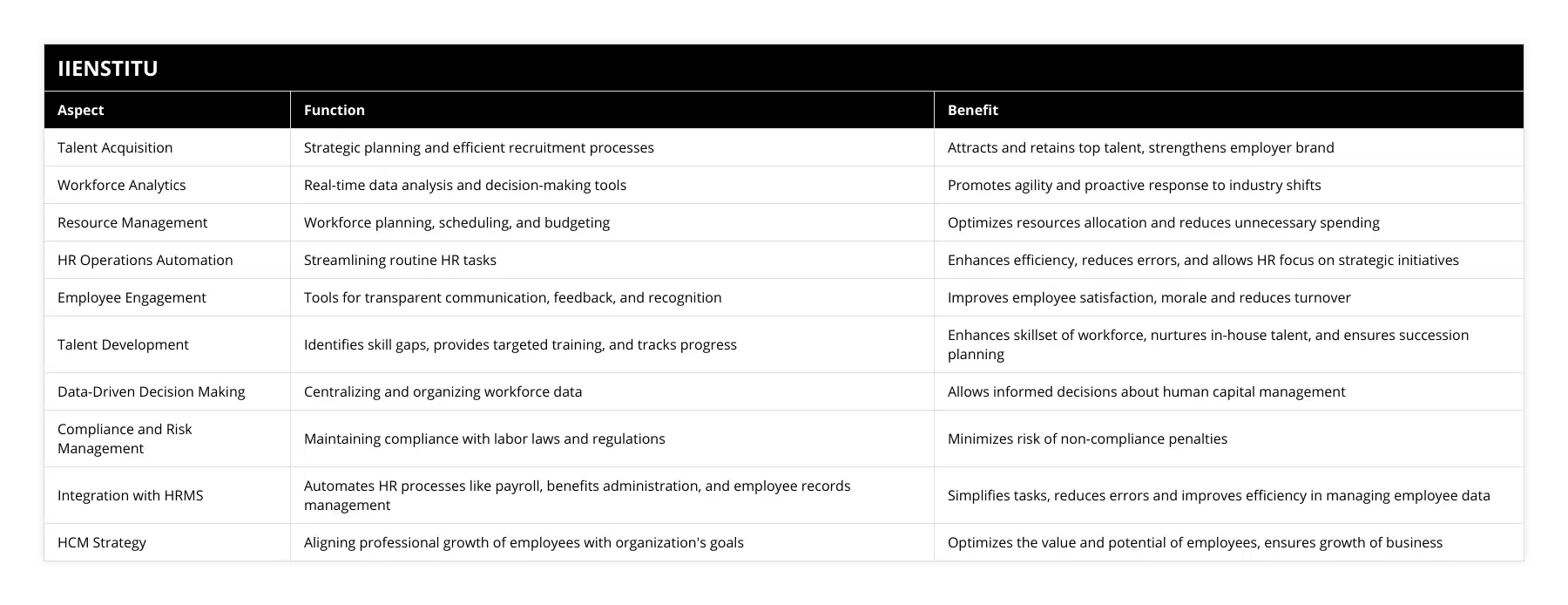
Frequently Asked Questions
What is Human Capital Management (HCM)?
Human Capital Management (HCM) is a comprehensive approach to managing an organization's workforce, encompassing recruitment, employee engagement, talent development, and retention strategies. It aims to optimize the value and potential of employees by treating them as vital assets, ensuring their professional growth aligns with the organization's goals. In addition, HCM extends beyond traditional HR practices by focusing on strategic planning, performance analysis, and the utilization of technology to enhance workforce management.
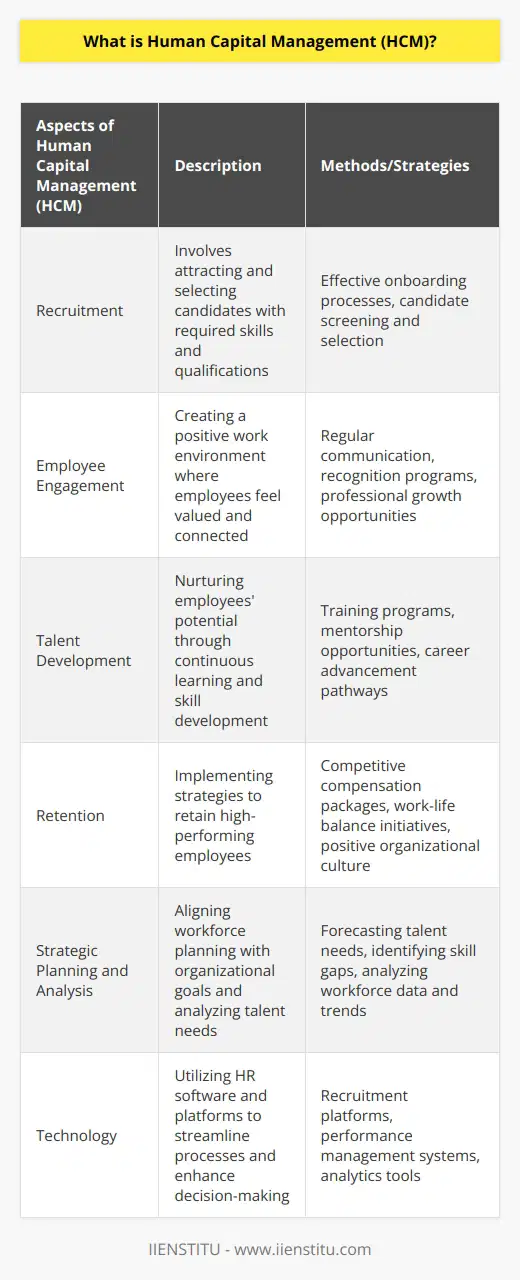
What is a human capital management strategy?
A human capital management strategy is a strategic framework organizations use to optimize the value of their workforce. This strategy involves identifying, attracting, developing, and retaining top talent while aligning employee goals with the organization's objectives. A successful HCM strategy focuses on the entire employee lifecycle, including recruitment, onboarding, performance management, career development, and succession planning. It also emphasizes creating a supportive work environment that fosters employee engagement, satisfaction, and productivity.
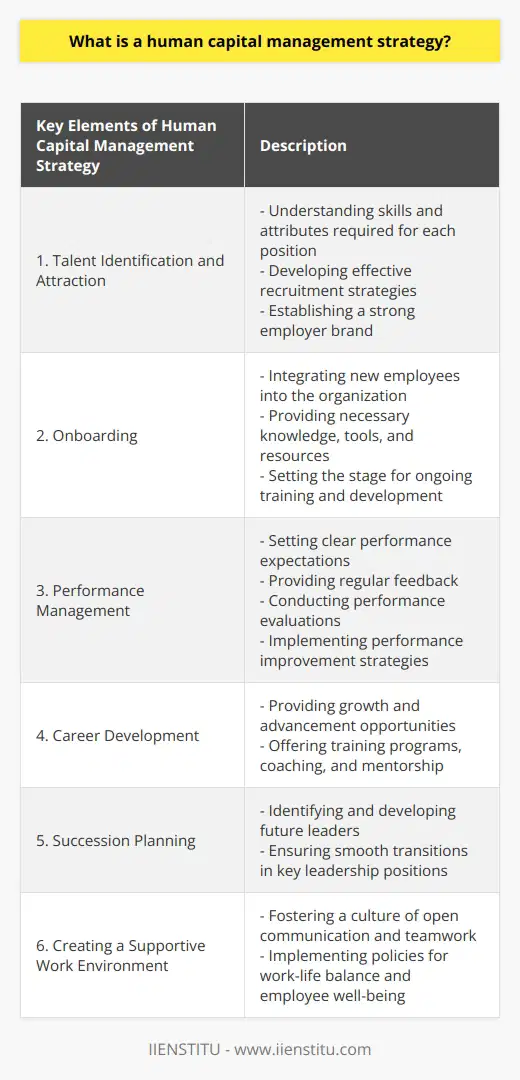
What is HCM vs. ERP?
HCM (Human Capital Management) is a discipline focused on managing an organization's workforce, including recruitment, talent development, and employee retention. In contrast, ERP (Enterprise Resource Planning) is a business management software that integrates various functions, such as finance, supply chain, and human resources, to streamline processes and facilitate decision-making. While HCM is primarily concerned with managing human resources, ERP is a broader system encompassing multiple organizational functions, including HCM.
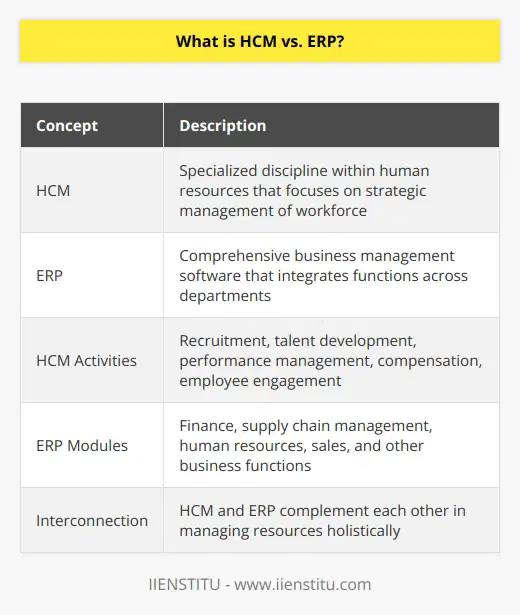
Why is human capital management critical?
Human capital management is crucial for organizations because it directly impacts their growth, productivity, and competitiveness. HCM helps attract and retain top talent, foster employee engagement and satisfaction, and ensure the strategic alignment of workforce goals with the organization's objectives. As a result, organizations can drive innovation, optimize workforce management, and enhance overall performance by effectively managing human capital.
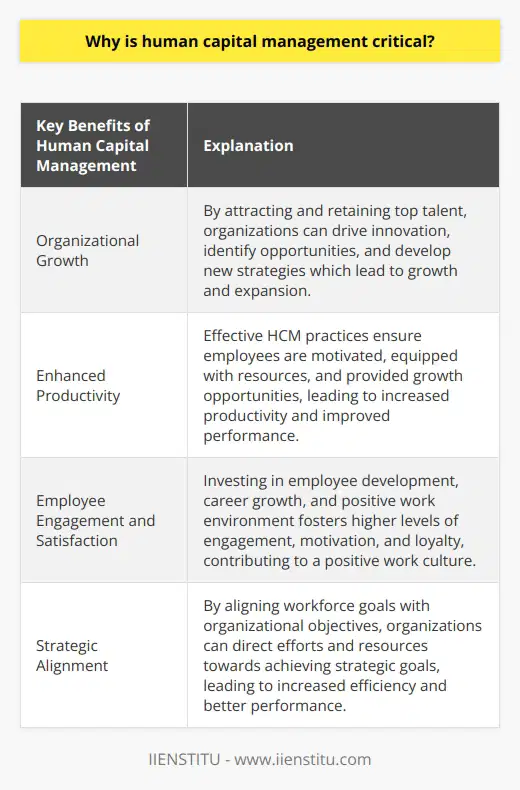
What does human capital management involve?
Human capital management involves a wide range of activities and processes to optimize the value of an organization's workforce. Some key aspects of HCM include:
Talent acquisition and recruitment
Onboarding and orientation
Performance management and evaluation
Employee engagement and satisfaction
Learning and development
Compensation and benefits administration
Succession planning and career growth
Workforce analytics and reporting
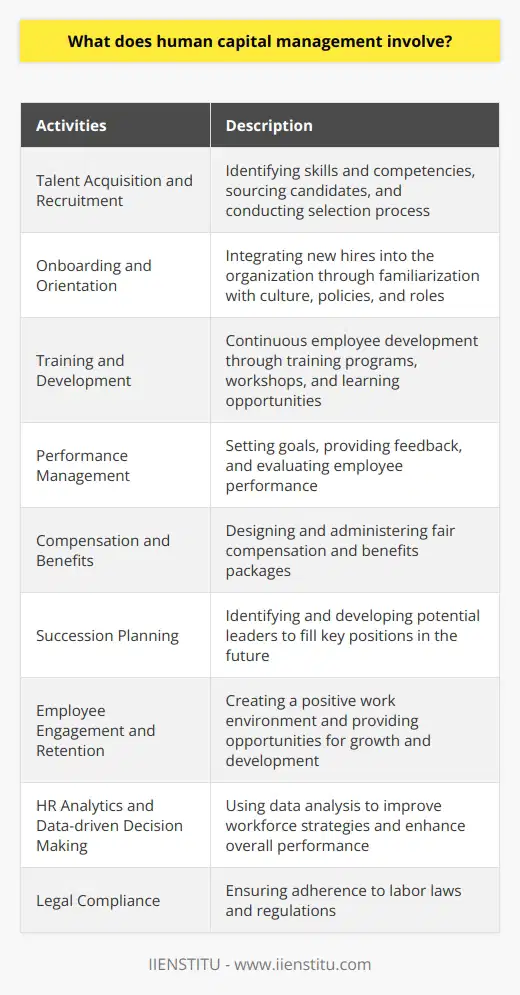
How to improve human capital management
To enhance human capital management, organizations can adopt the following practices:
Develop a clear HCM strategy that aligns with the organization's goals
Invest in technology and tools to streamline and automate HR processes
Foster a positive work culture that encourages employee engagement, collaboration, and inclusivity
Implement robust performance management systems that promote continuous feedback and growth
Offer tailored learning and development opportunities for employees
Develop competitive compensation and benefits packages to attract and retain talent
Utilize workforce analytics to make data-driven decisions and identify areas for improvement
